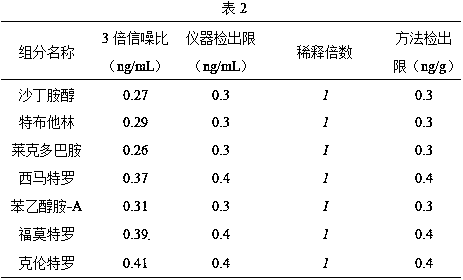Synthesis method of fluorescent probe with high fluorescence intensity and method for detecting beta-receptor agonist using it
A technology of receptor agonist and fluorescent probe, which is applied in the direction of fluorescence/phosphorescence, material analysis through optical means, and measurement equipment, etc., can solve the problems of fluorescence detection method limitations and weak fluorescence intensity, and achieve stable detection results and responsiveness. The effect of high speed and low detection cost
- Summary
- Abstract
- Description
- Claims
- Application Information
AI Technical Summary
Problems solved by technology
Method used
Image
Examples
Embodiment 1
[0030] The synthetic method of the fluorescent probe of embodiment 1 high fluorescence intensity is as follows:
[0031] Weigh the reactant 2,3-naphthalene diamine 8g, the reactant benzoyl chloride 7g, the catalyst and the solvent 1-butyl-3-methylimidazolium hexafluorophosphate 1g respectively in a round bottom flask according to the mass ratio, and stir evenly 30min, a mixed solution was obtained. The above mixed solution was extracted three times with 15 g of aqueous hydrochloric acid solution with a pH value of 2. Combine the hydrochloric acid solutions. Use 10% sodium hydroxide aqueous solution to adjust the pH value of the hydrochloric acid solution to 10, and a white crystal precipitate will be precipitated at this time. Filter, washing the filter cake several times with cold water. The filter cake was recrystallized with 50% ethanol aqueous solution and dried to obtain white needle-like crystals, namely 2-phenylnaphthimidazole, with a yield of 81.5%. Take 7g of chlo...
Embodiment 2
[0032] The synthetic method of the fluorescent probe of embodiment 2-high fluorescence intensity is as follows:
[0033]Weigh 8.2 g of the reactant 2,3-naphthalene diamine, 7.2 g of the reactant benzoyl chloride, and 1.2 g of the catalyst and solvent 1-butyl-3-methylimidazolium hexafluorophosphate in a round bottom flask according to the mass ratio , and stirred evenly for 30 min to obtain a mixed solution. The above mixed solution was extracted three times with 15.2 g of an aqueous hydrochloric acid solution with a pH value of 2. Combine the hydrochloric acid solutions. Use 10% sodium hydroxide aqueous solution to adjust the pH value of the hydrochloric acid solution to 10, and a white crystal precipitate will be precipitated at this time. Filter, washing the filter cake several times with cold water. The filter cake was recrystallized with 50% ethanol aqueous solution and dried to obtain white needle-like crystals, namely 2-phenylnaphthimidazole, with a yield of 81.5%. T...
Embodiment 3
[0034] The synthetic method of the fluorescent probe of embodiment 3-high fluorescence intensity is as follows:
[0035] Weigh 7.8g of the reactant 2,3-naphthalene diamine, 6.8g of the reactant benzoyl chloride, and 0.8g of the catalyst and solvent 1-butyl-3-methylimidazolium hexafluorophosphate in a round-bottomed flask according to the mass ratio , and stirred evenly for 30 min to obtain a mixed solution. The above mixed solution was extracted three times with 14.8 g of aqueous hydrochloric acid solution with a pH value of 2. Combine the hydrochloric acid solutions. Use 10% sodium hydroxide aqueous solution to adjust the pH value of the hydrochloric acid solution to 10, and a white crystal precipitate will be precipitated at this time. Filter, washing the filter cake several times with cold water. The filter cake was recrystallized with 50% ethanol aqueous solution and dried to obtain white needle-like crystals, namely 2-phenylnaphthimidazole, with a yield of 81.5%. Take...
PUM
 Login to View More
Login to View More Abstract
Description
Claims
Application Information
 Login to View More
Login to View More - R&D
- Intellectual Property
- Life Sciences
- Materials
- Tech Scout
- Unparalleled Data Quality
- Higher Quality Content
- 60% Fewer Hallucinations
Browse by: Latest US Patents, China's latest patents, Technical Efficacy Thesaurus, Application Domain, Technology Topic, Popular Technical Reports.
© 2025 PatSnap. All rights reserved.Legal|Privacy policy|Modern Slavery Act Transparency Statement|Sitemap|About US| Contact US: help@patsnap.com



